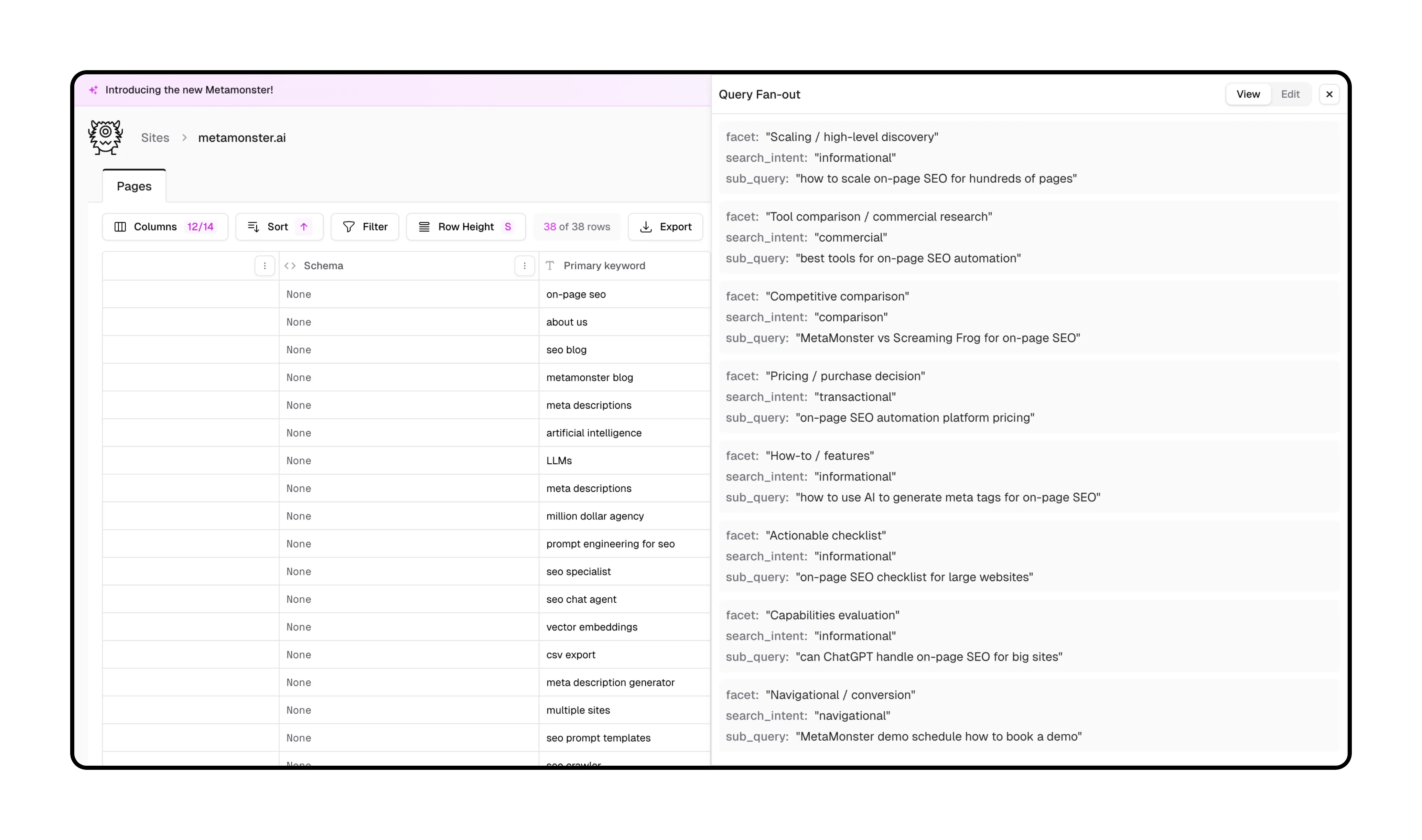How to analyze query fan-out patterns across your entire site (and why it matters for AI search)

If you’ve been following the latest SEO discussions, you’ve probably heard people talking about “query fan-out.”
Query fan-out is worth understanding because it can help you create more comprehensive content and potentially increase your chances of getting cited in AI-generated answers.
So what is it?
What query fan-out actually means
Query fan-out is how AI search engines like Google’s AI Mode, ChatGPT, and Perplexity handle complex queries. Instead of just matching your search to individual pages, they expand your question into multiple related sub-queries to build more comprehensive answers.
So when someone searches “how to clean white shoes,” the system might simultaneously consider:
- Best cleaning products for white sneakers
- How to remove stains from white leather
- DIY white shoe cleaning methods
- How to prevent white shoes from yellowing
- Professional shoe cleaning vs home methods
Then it pulls information from multiple sources to create one comprehensive response that addresses the original question plus things the searcher probably wants to know.
This is fundamentally different from traditional search, where you’d get a list of 10 blue links and have to piece together the information yourself.
How this affects content strategy
Traditional SEO was about optimizing each page for one or two keywords. But query fan-out suggests there’s value in creating more comprehensive content that goes beyond simple keywords and addresses related topics or questions.
When an AI system uses the query fan-out technique to answer a user’s prompt, it’s compiling results from the different subqueries into a single answer. A single page about “how to clean white shoes” might get cited if it covers the basics well. But if your content also addresses different materials, stain types, and prevention methods, it’s more likely to be included when the AI system pulls from multiple sources.
Understanding what sub-queries your content could potentially address helps you identify opportunities to make your existing content more thorough and useful.
The manual approach (and why automation helps)
You could analyze query fan-out manually. Pick a main topic, brainstorm related questions, check what’s ranking for each variation, map your content against those queries…
But if you’ve got hundreds or thousands of pages, this approach gets time-intensive quickly. But this is easy to do with AI, and we can use the same base model that Google uses for their AI mode - Gemini 2.5 Flash (although they use a modified version for their product query fan-out).
How to analyze query fan-out patterns at scale
We recently built a query fan-out analysis template in MetaMonster that automates this entire process. Instead of manually brainstorming sub-queries and checking coverage, you can analyze patterns across your entire site in minutes.
How the analysis works:
Our prompt template takes each page on your site and:
- Generates 10-15 related sub-queries across different search intents and facets that query fan-out might create
- Analyzes your existing coverage for each sub-query to identify gaps
- Stores everything in organized JSON so you can filter and sort results
The template uses Gemini 2.5 Flash by default (since we’re modeling Google’s behavior), but you can easily choose from any of the frontier models.
What you actually get:
Instead of guessing what related queries might be important, you get specific analysis like:
- For your homepage: Sub-queries might include your pricing plans, company values, contact information, customer reviews, competitor comparisons
- For product pages: Related queries could cover use cases, integrations, alternatives, pricing tiers, setup requirements
- For blog posts: Fan-out might generate queries about implementation, related tools, case studies, advanced techniques
Each sub-query comes with a coverage analysis that tells you whether your existing content adequately addresses that topic or if there’s a gap.
Practical insights from running this analysis
When I tested this on our own site, the results were interesting! Our about page mentioned “direct access to founders” but didn’t provide explicit contact information. Our homepage talked about pricing plans but didn’t include a complete breakdown.

These represent opportunities to make our content more comprehensive. When someone searches for information about MetaMonster, the AI system might generate sub-queries about our contact info or pricing details. Having that information clearly available could increase our chances of being cited (an idea we’ll be testing soon).
How to implement query fan-out analysis
Start with your most important pages:
You don’t need to analyze your entire site at once. Begin with:
- Homepage and main service pages
- Top-performing blog posts
- Key product or feature pages
- Pages that drive conversions
Use the analysis to prioritize content updates:
Look for patterns in the coverage analysis:
- True/covered: Your content adequately addresses the sub-query
- False/gaps: Clear opportunities to expand or improve content
- Partial coverage: Areas where you mention the topic but could go deeper
Focus on expanding rather than creating: In most cases, you’ll find that updating existing content to address more sub-queries is more effective than creating entirely new pages. This builds topical authority and gives AI systems more comprehensive sources to cite (plus the data suggests AI agents use recency of updates as a major ranking factor).
Making query fan-out analysis part of your workflow
For existing content: Run the analysis on existing content to identify gaps where you could deepen your coverage around a specific query. You can do this in a couple of clicks with our prompt templates and table interface.
For new content: Before creating a new page, analyze what sub-queries it should address and ensure comprehensive coverage. You can use our chat agent to quickly explore this with a prompt like:
You are an expert SEO search intent analyst. Help me plan comprehensive content that addresses query fan-out.
**INPUT:**
- Primary topic/keyword: [YOUR_TOPIC]
**TASK:**
1. Generate 10-15 related subqueries across different search intents (informational, commercial, transactional, navigational) and facets (discovery, features, comparisons, problems, user types, etc.)
2. Prioritize which subqueries should be addressed in this content piece
**REQUIREMENTS:**
- Use natural language variations people actually search
- Cover different user journey stages
- Focus on subqueries that would make sense to address together in one comprehensive piece
**OUTPUT:**
Provide results as a CSV with columns: facet, sub_query, search_intent, priority, content_suggestion
For client reporting: Show clients how their content performs in the context of AI search, not just traditional rankings
What this means as search continues evolving
Query fan-out reflects the broader trend toward AI systems providing direct answers rather than just lists of links. Creating comprehensive content that addresses related sub-queries can help you stay relevant as this trend continues. Which mirrors the topic-first SEO approach we talked about in our recent guide.
But this works alongside traditional SEO fundamentals, not instead of them. Good content still needs proper technical optimization, clear structure, and genuine value for users. Query fan-out analysis is just one tool for ensuring your content is thorough enough to be useful in different contexts.
Traditional ranking factors still matter. Understanding query fan-out just gives you another lens for evaluating and improving your content.
Ready to analyze your content for query fan-out?
If you want to see how query fan-out analysis works with your specific content, schedule a demo and we’ll walk through the process with your actual pages.
Or if you’re ready to start experimenting, our query fan-out template is available to all MetaMonster users as part of our prompt template library. You can run the analysis on specific pages or across your entire site, then export the results to share with your client. Sign up for free today to give it a try.
The SEO landscape keeps evolving, but having tools that help you adapt quickly makes all the difference.
Want to learn more about query fan-out? Dive deeper with these great posts:
Drowning in client work but unwilling to compromise on quality?
Automate the grunt work with MetaMonster. Your first 500 credits are free. Crawl your first site to see how MetaMonster can transform your workflows.